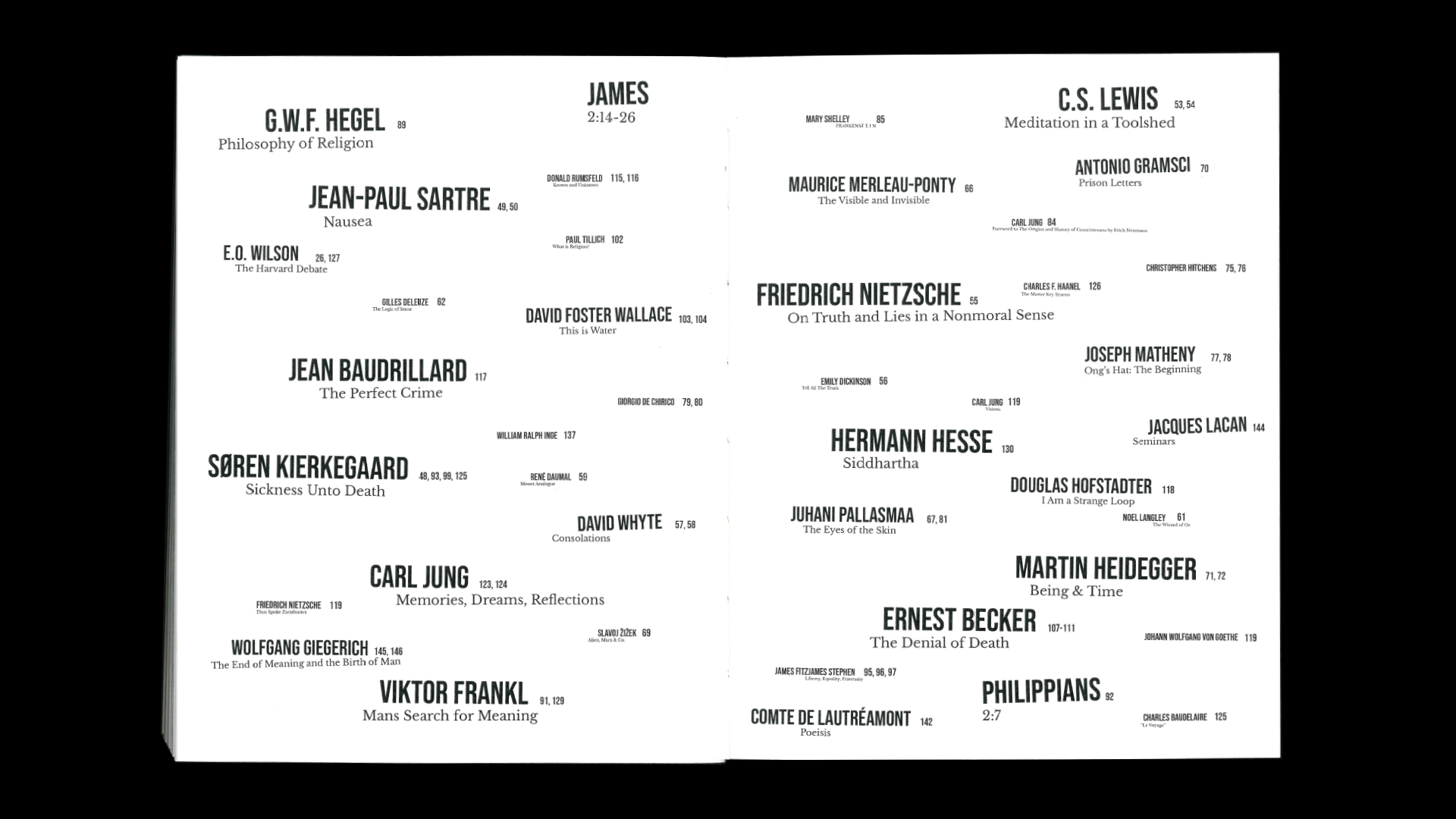IN OTHER WORDS / BOOK DESIGN
OVERVIEW
‘In Other Words’ is used as a grammatical translation device, it is used to repeat or re-present what has already been said in a simpler and more precise way.
This book is about reading and re-membering. About re-mixing and re-composing, discourse, personal stories, and meaning-making. And it’s about re-constructing the invisible picture through text and image.
The journey of a designer’s self-understanding and territories of responsibility have widened in recent decades to include and address questions of authorship, meaning at the intersection of language, art, design, and theory, as well as organizing, writing, and curating bodies of text.
It is the place of art and design that allow us to dig deeper into the roots of who we are.
We’re always being-with-others. When we read others words it transports us into a small vision of their worlds. Following the death of the author I was fascinated by trying to re-bind (religio) a bunch of different thinkers that were writing in different times and sometimes even languages into a pluralistic compendium or common place. Sort of like how the bible is a library, I wanted to make my own little library (or arcades project/literary montage) of the others who have most influenced my thinking over the past 4 years of university.
The main thread throughout the book is focused on an underlying tension of transformation from point a to point b (the book uses exposed white kettle stitched binding). I was interested in the way we make meaning through the symbolic world. The start of the book is printed in black and white until there is a kairotic moment, a moment of opportune time. Sort of like the opening to the Wizard of Oz where Dorothy opens the door and technicolour is introduced into the metaphysical world for the first time in television history.
The typographic treatment shifts and splits throughout the narrative. The book was created on the heels of covid, a time of crisis for many. Many people were forced online and into isolation. The weltgeist was further apart than ever physically yet all distances had vanished through the speed of the internet. This is a document of some of that transformation I saw happening, a design diary.
This is really a work on oneself. It might be a little bit navel gazey but I think it was such a good practice for discovering my voice and my relation to these ideas that I've been drawn to. I think of it as planting a garden, each author is a seed, sometimes I plant 2 seeds next to one another and they don't graft well together. Some don't take root. Some grow into massive olive trees.
I’ve always struggled finding the right words to explain myself, but maybe there aren’t any. Maybe the most important words are the ones left unsaid. All of these—my—words are by definition, limited. They are subjective, situated in time and space, in this particular body with its own particular slippery history. This story that I tell is slippery and fluid, like the insides of our bodies. Language is slippery and words create worlds. I speak through a choir of influence. I embrace phrases, make use of expressions, erase false ideas and replace them with right ones. Inside are the books that have transformed my Being-in-the-world.
In Other Words, you are the co-creator of this story. Our stories create our reality. The transformation of the author is the message.
‘In Other Words’ is used as a grammatical translation device, it is used to repeat or re-present what has already been said in a simpler and more precise way.
This book is about reading and re-membering. About re-mixing and re-composing, discourse, personal stories, and meaning-making. And it’s about re-constructing the invisible picture through text and image.
The journey of a designer’s self-understanding and territories of responsibility have widened in recent decades to include and address questions of authorship, meaning at the intersection of language, art, design, and theory, as well as organizing, writing, and curating bodies of text.
It is the place of art and design that allow us to dig deeper into the roots of who we are.
We’re always being-with-others. When we read others words it transports us into a small vision of their worlds. Following the death of the author I was fascinated by trying to re-bind (religio) a bunch of different thinkers that were writing in different times and sometimes even languages into a pluralistic compendium or common place. Sort of like how the bible is a library, I wanted to make my own little library (or arcades project/literary montage) of the others who have most influenced my thinking over the past 4 years of university.
The main thread throughout the book is focused on an underlying tension of transformation from point a to point b (the book uses exposed white kettle stitched binding). I was interested in the way we make meaning through the symbolic world. The start of the book is printed in black and white until there is a kairotic moment, a moment of opportune time. Sort of like the opening to the Wizard of Oz where Dorothy opens the door and technicolour is introduced into the metaphysical world for the first time in television history.
The typographic treatment shifts and splits throughout the narrative. The book was created on the heels of covid, a time of crisis for many. Many people were forced online and into isolation. The weltgeist was further apart than ever physically yet all distances had vanished through the speed of the internet. This is a document of some of that transformation I saw happening, a design diary.
This is really a work on oneself. It might be a little bit navel gazey but I think it was such a good practice for discovering my voice and my relation to these ideas that I've been drawn to. I think of it as planting a garden, each author is a seed, sometimes I plant 2 seeds next to one another and they don't graft well together. Some don't take root. Some grow into massive olive trees.
I’ve always struggled finding the right words to explain myself, but maybe there aren’t any. Maybe the most important words are the ones left unsaid. All of these—my—words are by definition, limited. They are subjective, situated in time and space, in this particular body with its own particular slippery history. This story that I tell is slippery and fluid, like the insides of our bodies. Language is slippery and words create worlds. I speak through a choir of influence. I embrace phrases, make use of expressions, erase false ideas and replace them with right ones. Inside are the books that have transformed my Being-in-the-world.
In Other Words, you are the co-creator of this story. Our stories create our reality. The transformation of the author is the message.
SERVICES
Creative Direction
Print Design
Type Design
Kettle Stitch Binding
Creative Direction
Print Design
Type Design
Kettle Stitch Binding
YEAR
2022-2023
2022-2023

University of Toronto professor John Vervaeke, right. Colin Lawrence, left. Pictured at OCAD University, Grad Ex 2023





 © 2025,
All Rights Reserved
© 2025,
All Rights Reserved